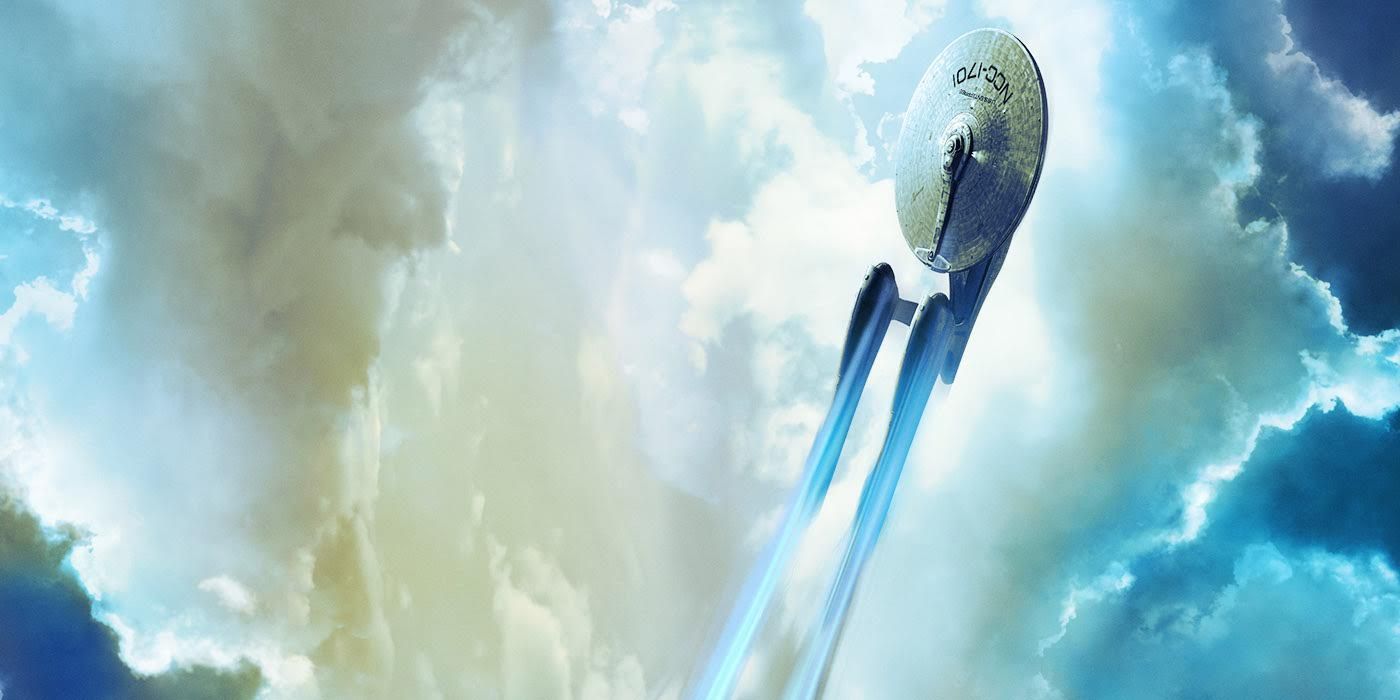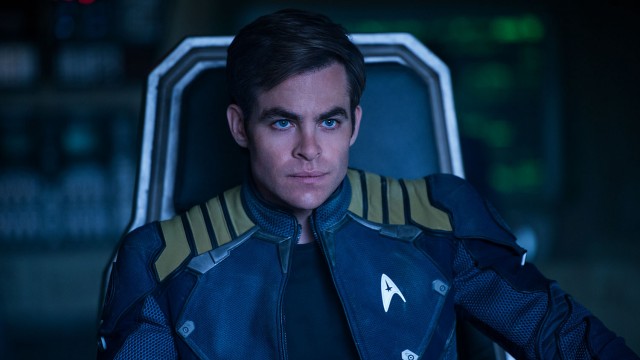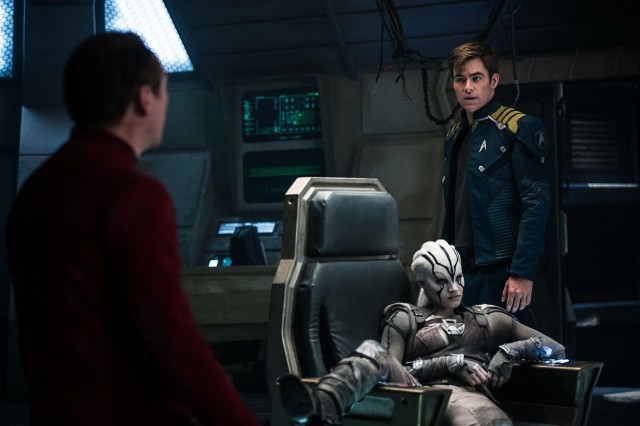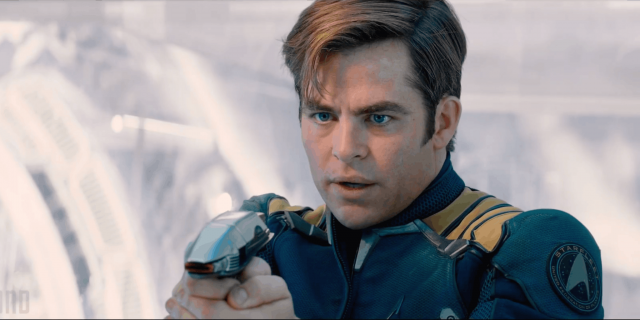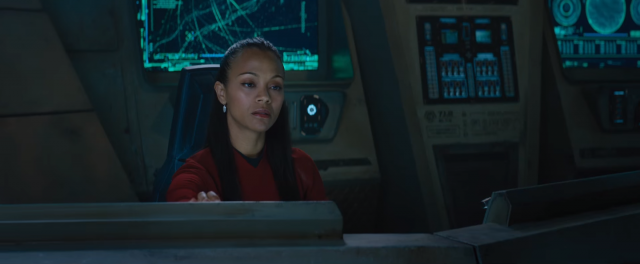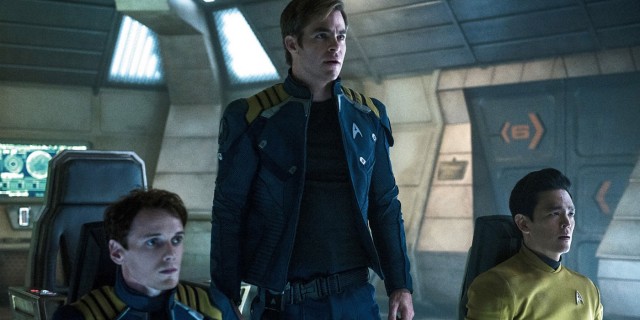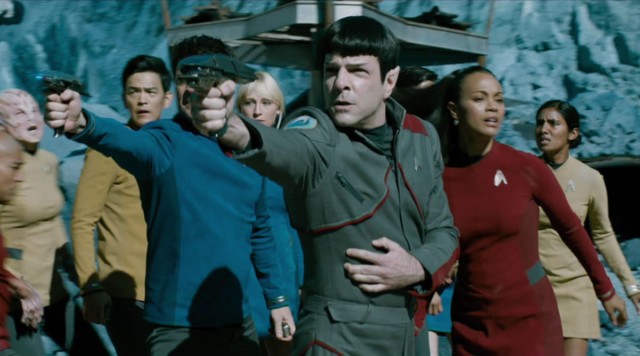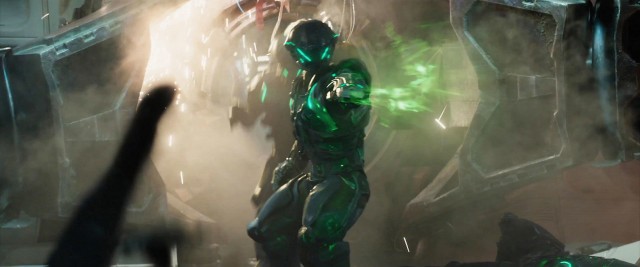Star Trek is observing its landmark 50th anniversary in 2016, and that already puts enough pressure on Star Trek Beyond, Paramount’s latest movie in the franchise’s rebooted Kelvin Timeline saga, to deliver. Adding to the odds working against the movie was the departure of director J.J. Abrams, who defected to directing last year’s Star Wars: The Force Awakens for Disney and LucasFilm, leaving Star Trek Beyond to lean even further into the Kelvin Timeline’s more traditional action-blockbuster-focused direction by hiring on veteran Fast and Furious movie director, Justin Lin to helm the production, with Abrams staying involved in a producers’ capacity.
Despite all of the elements seemingly working against Star Trek Beyond however, it comes as a very pleasant surprise that the movie actually does an even better job than Abrams’ movies at appealing to the sensibilities of classic Star Trek, making it a surprisingly fitting cinematic offering for the franchise’s 50th anniversary. Even better is that Star Trek Beyond is actually a pretty great Star Trek movie on its own merits, even if it does hit a lot of familiar beats among Star Trek media and sci-fi media in general.
One could feasibly chalk some of the predictable turns up to honouring the legacy of Star Trek though, and that will definitely be fair enough to longtime fans. Indeed, both long-running and brand new fans of Star Trek will find plenty to like about Star Trek Beyond, which is an exciting and fun new installment for the Kelvin Timeline and the franchise in general, and feels a bit more entertaining than 2013’s good, but dreary Star Trek Into Darkness. Abrams’ duo of Star Trek movies definitely had more style, but there’s something very earnest and likable about Lin’s offering, which gets down to the heart of the franchise in an inspired way, while maintaining the more thrilling direction that defines the Kelvin Timeline’s movies.
Abrams’ Star Trek movies incorporated all of the classic Star Trek leads from Star Trek: The Original Series, but it’s tough to argue that Chris Pine’s James T. Kirk and Zachary Quinto’s Spock were given the most screentime and bearing on the story in both movies. Star Trek Beyond however is more of a true ensemble piece, not focusing on any one character on the U.S.S. Enterprise’s crew, and instead giving every lead personality on the Enterprise their own chance to shine and help move the story forward.
This also allows the movie to spotlight classic friendships and partnerships from former Star Trek media that have been pretty much ignored in the Kelvin Timeline up to this point. The core leads are split after the movie’s first act, after they’re forced to abandon ship and take refuge on a nearby alien planet, and this separating of the crew is why Star Trek Beyond succeeds so much as an ensemble movie. Considering the very extensive history of Star Trek stories, there’s very few ways that the Star Trek franchise can fully avoid re-treading old ground in the storytelling at this point, though it could always compensate with the appeal of its great characters.
Star Trek Beyond knows this, and it uses the personalities in equal measure to compensate for a fairly by-the-numbers Star Trek story. Pine and Quinto are still big standouts in the cast, but they’re no longer working directly off of each other for most of the movie. Instead, Pine is marooned with Anton Yelchin’s Chekov, while Spock is instead paired up with Karl Urban’s Doctor McCoy. Fans of McCoy can rest assured that his character is put to way better use in this movie than he was in Star Trek Into Darkness as well, and his chance to play off of Spock actually leads to some of the movie’s best humour and character moments.
Zoe Saldana’s Uhura and John Cho’s Sulu are given a bit less to do, especially since they aren’t given free reign on the alien planet in the way that the other characters are, but there’s still little touches in dialogue, action and backstory that add cool new dimensions to their characters, some of which even provide some pretty interesting shifts from classic Star Trek canon once again. Fortunately though, Anton Yelchin’s Chekov is given arguably his best movie of the three in the Kelvin Timeline here, in terms of his entertainment value and resourcefulness, which feels satisfying, especially since Yelchin tragically passed away shortly before the movie hit theatres, and the movie is dedicated to both him and the late Leonard Nimoy, who passed away himself during pre-production, preventing Spock Prime from once again being featured in the Kelvin Timeline.
A lot of the character appeal in Star Trek Beyond also comes from the very smart and enjoyable script that was co-written between Doug Jung, and one of the Kelvin Timeline’s own actors, Simon Pegg. Pegg still gives himself some standout comedic lines and actions as Scotty, but Pegg’s love of Star Trek clearly runs deep on all sides, especially since his script gives Scotty the risky path of being the character to first meet the franchise’s new hero, alien warrior, Jaylah, played by Kingsman: The Secret Service’s Sofia Boutella. Jaylah is actually a fantastic new character as well, being an empowered, strong, funny and interesting heroine that provides a cool alien perspective on the actions of Starfleet, and the plight of the Enterprise crew. Considering that Chekov can’t return to the Kelvin Timeline in the already-confirmed fourth movie, due to Anton Yelchin’s tragic passing, I wouldn’t be opposed to Jaylah joining the Enterprise Crew and filling the void in the next Star Trek movie, since her presence as both a woman and an alien will provide more cool diversity to the Enterprise’s crew, especially when she’s such a great character overall.
This leads me to the movie’s villain, Krall, played by Idris Elba, who seems to have some sort of unspecified grudge against Starfleet, and is targeting the Enterprise crew as a result. Elba’s performance is nicely menacing, though it’s not until the third act that his character truly becomes memorable among the legions of Star Trek antagonists, thanks to a great twist that ties him more personally into the franchise’s heart and ideals. It’s a shame that Krall’s villainy takes a fair bit of time to truly feel impactful, but at least Elba’s villainous charisma compensates nicely, and his forces do provide an especially cool and satisfying threat to the Enterprise’s crew, making Krall and his army probably the best antagonists that the Kelvin Timeline has seen yet.
Star Trek Beyond is effortlessly entertaining and constantly exciting, especially when its dialogue and character work is so well done. A noticeable drawback to the movie however, and something that does hold it back a bit in contrast to Abrams’ two movies, is that it sticks a lot more closely to the franchise’s comfort zone. When it comes down to it, there aren’t too many curveballs in the story, beyond the twist with Krall, and some longtime Star Trek fans may see that coming in advance. The Enterprise crew respond to a distress call, get marooned on a planet, have to survive while being targeted by a villain, and somehow get back to Starfleet. That’s the whole storyline in Star Trek Beyond. Like I said, it doesn’t stray too far from plenty of other story templates from throughout Star Trek’s lengthy history of media.
As a 50th anniversary movie though, Star Trek Beyond is very satisfying, especially since it does keep improving as the runtime goes on, creating a steady curve of reliable entertainment value. For what the movie lacks in storytelling innovation, it more than makes up for in how fun and enjoyable it is to watch. It’s a conservative, but well-produced and tightly-constructed Star Trek movie, and one that makes for a very entertaining blockbuster to enjoy this Summer, regardless of how much or how little Star Trek you’ve seen beforehand.
One of the biggest questions surrounding Star Trek Beyond is how the movie would shape up without J.J. Abrams in the directors’ chair, especially considering how heavily Abrams was involved in constructing the entire Kelvin Timeline. Fortunately, Justin Lin is actually a pretty worthy replacement, especially considering the clear eye that Lin has displayed with action-flavoured blockbusters in the Fast and Furious movies that he helmed. As you can expect, Lin has no trouble making Star Trek Beyond a very exciting movie, realizing every action scene very well, and often injecting quite a bit of creativity into the movie’s action sequences, which are no less ambitious and cool than they were in Abrams’ Star Trek movies.
Another great element to Lin’s direction is that Lin clearly loves Star Trek, and clearly has a deep-rooted understanding of what drives this franchise, and what makes a good Star Trek story. It’s because of this that Lin’s movie seems to feel more like classic Star Trek in contrast to Abrams’ two movies, yet not at the expense of the blockbuster-friendly thrills that have come to heavily define the Kelvin Timeline. The way that Lin’s direction highlights classic Star Trek sensibilities in inspired ways, then brings everything together for a perfect celebration of the series’ 50th anniversary in a very riveting climax, is especially impressive, and one of the main things that makes Star Trek Beyond feel like the perfect companion offering for the franchise’s huge milestone this year.
The one area where Lin’s direction feels like it’s noticeably trailing Abrams’ direction, despite Lin’s equal panache for both character beats and action sequences in Star Trek Beyond, is that Star Trek Beyond does feel a bit less flashy and polished than its two predecessors do. A lot of this could simply be attributed to Abrams being a really tough act to follow when it comes to distinct, slick-looking sci-fi visual directing, but Lin seems to go for more grit and less flash in his visual directing, which is fair enough, but it probably won’t impress as much as Abrams’ style did. Even with the added grit though, Lin’s movie still very much feels like an authentic Star Trek production in every respect, and it doesn’t compromise anything when it comes to realizing exactly what makes this franchise tick so well.
Even with Abrams no longer directing for Star Trek Beyond, Michael Giacchino nonetheless returns to compose the movie’s score, after composing the soundtracks of the Kelvin Timeline’s prior two Star Trek movies. This means that some of the familiar musical themes for the Kelvin Timeline show up again, amidst a score that is a bit more atmospheric and ominous, but still has a few fun action compositions. All in all, the score is serviceable, even if Giacchino did better work in the prior two movies’ music scores, though the tie-in single by Rihanna, “Sledgehammer”, is at least a bit more interesting. As much as some may be cynical about a tie-in pop single for Star Trek Beyond, the Rihanna tune is not bad and fairly catchy, even if it has very little to do with Star Trek itself.
The rest of the audio work is generally great though, especially considering that Lin’s added focus on grit leads to action that sounds more destructive and violent than it did before. Abrams’ movies still packed plenty of punch in the audio department, though they did emphasize more of a fantastical element than Lin’s more intense and chaotic action scenes do. Lin’s movie actually sounds very gripping in IMAX theatres and other such premium formats as well, making the audio boost worth springing for, if you especially crave excitement from a Star Trek movie.
As I said, J.J. Abrams is a very tough act to follow in the visual department, and that’s pretty apparent in Star Trek Beyond, which is still a great-looking Star Trek movie, but it still takes a visual hit compared to its two predecessors that Abrams helmed. Still, the movie feels like Star Trek through and through, trading in some of the gloss in the director change, but still feeling atmospheric and well-realized. The alien planet that most of Star Trek Beyond takes place on feels especially neat and exotic, but where the movie is at its visual best is during the spacefaring battle sequences at the end of the first act and in the climax. These visual moments still aren’t on Abrams’ level, but they’re nonetheless above the visual class of many other movies, even some large-scale ones.
As for the 3D elements in the movie, they’re decent, but much like Star Trek Into Darkness, they’re nothing exceptional, which still feels surprising, since you’d think that Star Trek would lend itself pretty well to a 3D presentation. The spacefaring sequences do utilize the 3D a little bit more, and that boost may make the price worth it for people who enjoy 3D movies, but you’re not missing as much as you think if you watch the movie flat in 2D. The IMAX 3D cut adds a small boost to the atmosphere, but not enough to justify the added ticket price. The main strength of the IMAX showings seems to be the audio boost, which is already pretty great in regular theatres. Star Trek Beyond never feels ugly or visually underwhelming, regardless of your choice of visual format, but the premium formats like 3D and IMAX 3D are merely passable, rather than truly being worth the money for those who could care less about these supposed upgrades.
Star Trek Beyond might have seemed like a downgraded movie sequel from the somewhat unimpressive marketing that led up to its release, but it noticeably exceeds those lowered expectations, being a very competent and highly enjoyable Star Trek movie for both old fans and newcomers. The movie is a bit less stylish and a bit more predictable than Abrams’ two Star Trek movies, but it’s at least a bit more enjoyable to watch than the previous Star Trek Into Darkness, even if, as an overall package, it doesn’t manage to exceed 2009’s Star Trek especially.
All in all though, among 2016’s Summer blockbusters, Star Trek Beyond is definitely one of the better ones, especially if you’ve always loved this franchise throughout most of your life. It’s an intense, but ultimately uplifting celebration of Star Trek and its contribution to pop culture, though one that still provides an engaging, if straightforward sci-fi/action blockbuster storyline that even the most uninitiated of Star Trek viewers will easily be able to follow and enjoy. Even on the third movie, Star Trek Beyond also clearly demonstrates that the Kelvin Timeline has yet to run out of steam, and that makes the fact that a fourth movie is already in the works feel all the more exciting, even if it sadly won’t include Leonard Nimoy or Anton Yelchin.
Star Trek Beyond doesn’t ultimately raise the standard for the Star Trek franchise, especially considering how closely it sticks to this franchise’s familiar playbook, but it does feel like the perfect way to observe the franchise’s 50th anniversary, since it brings together all of the essential Star Trek ingredients into one highly satisfying cinematic production. If you’re no stranger to flying with the Enterprise, you’ll find that the movie’s journey is one that you’ve no doubt taken before, but at the very least, a good old-fashioned Star Trek romp like this has rarely been this cool or exciting to experience.

